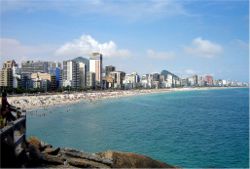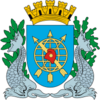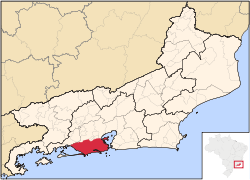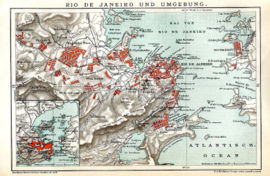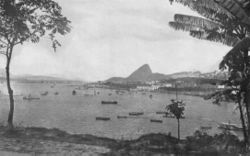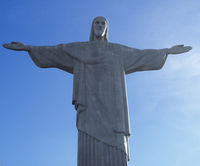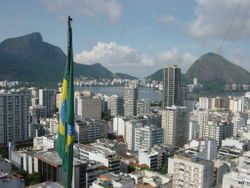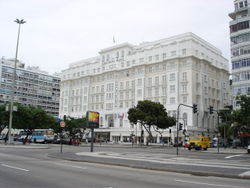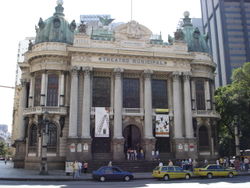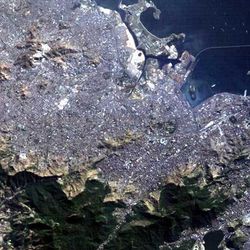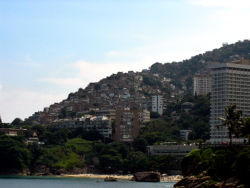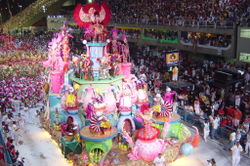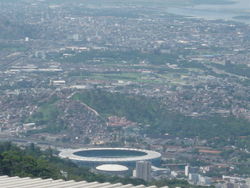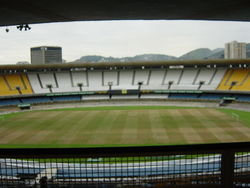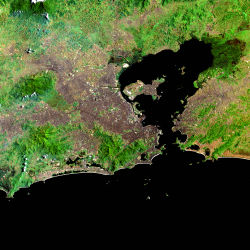Rio de Janeiro
2007 Schools Wikipedia Selection. Related subjects: Central & South American Geography
| Rio de Janeiro | |||||
| Rio de Janeiro | |||||
|
|||||
| Location of Rio de Janeiro | |||||
| Coordinates: | |||||
|---|---|---|---|---|---|
| Country | Brazil | ||||
| Region | Southeast | ||||
| State | Rio de Janeiro | ||||
| Mayor | Cesar Maia ( PFL) | ||||
| Area | |||||
| - City | 1,260 km² | ||||
| Population | |||||
| - City (2005) | 5,613,000 | ||||
| - Density | 4.781 inhabitants per km²/km² | ||||
| - Metro | 11,620,000 | ||||
| Time zone | UTC-3 ( UTC-3) | ||||
| Website: www.rio.rj.gov.br | |||||
Rio de Janeiro ( pron. IPA [ˈʁiu dʒi ʒaˈneiɾu]; Portuguese for River of January) is the name of both a state and a city in southeastern Brazil. The city was the capital of Brazil ( 1763- 1960) and of the Portuguese Empire ( 1808- 1821). Commonly known as just Rio (particularly in English and by its inhabitants), the city is also nicknamed A Cidade Maravilhosa - "The Marvelous City".
It is famous for its spectacular natural setting, its Carnival celebrations, samba and other music, hotel-lined tourist beaches, such as Copacabana, Ipanema, and Leblon, pavements decorated with black and cream swirl pattern mosaics, and the easygoing lifestyle of its inhabitants. Some of the most famous local landmarks in addition to the beaches include the giant statue of Jesus, known as Christ the Redeemer ('Cristo Redentor') atop Corcovado mountain; Sugar Loaf mountain (Pão de Açúcar) with its cable car; the Sambódromo, a giant permanent parade stand used during Carnival; and Maracanã stadium, one of the world's largest. Rio also boasts the world's largest forest inside an urban area, called Floresta da Tijuca, or ' Tijuca Forest'.
Rio de Janeiro is located at 22 degrees, 54 minutes south latitude, 43 degrees 14 minutes west longitude (). The population of the City of Rio de Janeiro is about 6,094,183 ( 2005 IBGE estimate), occupying an area of 1182.3 km² (456.5 mi²) . The larger metropolitan area population is estimated at 11-12 million. It is Brazil's second-largest city after São Paulo and was the country's capital until 1960, when Brasília took its place. Residents of the city are known as Cariocas. The city's current mayor (2006) is Cesar Maia. The official song of Rio is " Cidade Maravilhosa."
History
Guanabara Bay, future site of the city, was reached by Portuguese explorers in an expedition led by Portuguese explorer Gaspar de Lemos on January 20, 1502; hence Rio de Janeiro, "River of January". There is a legend that the mariners named the place thus because they thought the mouth of the bay was actually the mouth of a river, but no experienced sailor would make that mistake. At the time, river was the general word for any large body of water.
Unofficial European presence in the area began not long after. In 1519 when Ferdinand Magellan resupplied his ships in the bay, French smugglers were already using the bay as a post for smuggling brazilwood. When French naval officer Nicolas Durand de Villegaignon arrived in 1555 with a fleet of two ships and 600 soldiers and colonists, he founded the first permanent European settlement in the area. The colony was referred to as " France Antarctique". The colonists consisted of mainly French Huguenots and Swiss Calvinists. Villegaignon left in 1557 after contentions with some the colonists.
The actual city was founded in March 1, 1565, by Portuguese knight Estácio de Sá, who called it São Sebastião do Rio de Janeiro (St Sebastian of the January River), in honour of King Sebastian I of Portugal. For centuries, the settlement was commonly called São Sebastião – or even 'Saint Sebastian' – instead of the currently popular second half of its name. The city was founded as a base from which to invade the French settlement. They succeeded in 1567 and the French were expelled. Later, São Sebastião was frequently attacked by pirates and privateers, especially by then enemies of Portugal, such as the Netherlands and France.
The exact place of Rio's foundation is at the foot of Pão-de-Açúcar (Sugarloaf Mountain). Later, the whole city was moved within a palisade on top of a hill, imitating the medieval European defence strategy of fortified castles – the place has since then been called Morro do Castelo (Castle Hill). Thus, the city developed from the current centre (Downtown, see below) southwards and then westwards (with large parts built over reclaimed land); an urban movement which continues today.
In the late 16th century the Portuguese crown began treating the village as a strategic location for the Atlantic transit of ships between Brazil, the African colonies and Europe. Fortresses were built and an alliance was formed with nearby native tribes to defend the settlement against invaders – Rio's neighbour, Niterói, for instance, was founded by a native chief for the purpose of supporting defence, the Tamoio Indian Araribóia. Sugar cane was the first industry in the area. First native, and later African, slaves were used for manual labor. Eventually the industry dwindled as higher quality sugar cane from northern Brazil became more available.
Until early in the 18th century the city was threatened or invaded by several – mostly French – pirates and buccaneers, such as Jean-François Duclerc and René Duguay-Trouin. After 1720, when the Portuguese found gold and diamonds in the neighbouring captaincy of Minas Gerais, Rio de Janeiro became a much more useful port for exporting wealth than Salvador, Bahia, which is much farther to the north. In 1763, the colonial administration in Portuguese America was moved to Rio.
The city remained primarily a colonial capital until 1808, when the Portuguese royal family and most of the associated Lisbon nobles, fleeing from Napoleon's invasion of Portugal, moved to Rio de Janeiro. The kingdom's capital was transferred to the city, which, thus, became the only European capital outside of Europe. As there was no physical space or urban structure to accommodate hundreds of noblemen who arrived suddenly, many inhabitants were simply evicted from their homes.
When Prince Pedro I proclaimed the independence of Brazil in 1822, he decided to keep Rio de Janeiro as the capital of his new empire, but, by then, the city region was gradually losing importance – economic and political – to São Paulo.
Rio continued as the capital of Brazil after 1889, when the monarchy was replaced by a republic.
Until the early years of the 20th century the city was largely limited to the neighbourhood now known as the historic Downtown business district (see below), on the mouth of Guanabara Bay. The city's centre of gravity began to shift south and west to the so-called Zona Sul (South Zone) in the early part of the 20th century, when the first tunnel was built under the mountains located between Botafogo and the neighbourhood now known as Copacabana. That beach's natural beauty, combined with the fame of the Copacabana Palace Hotel, the luxury hotel of the Americas in the 1930s, helped Rio to gain the reputation it still holds today as a beachy party town (though, this reputation has been somewhat tarnished in recent years by favela violence resulting from the narcotics trade).
Plans for moving the nation's capital city to the territorial centre had been occasionally discussed, and when Juscelino Kubitschek was elected president in 1955, it was partially on the stength promises to build a new capital. Though many thought that it was just campaign rhetoric, Kubitschek managed to have Brasília built, at great cost, by 1960. On April 21 that year the capital of Brazil was officially moved from Rio de Janeiro to Brasília.
Between 1960 and 1975 Rio was a city-state (such as Hamburg, or Bremen in Germany) under the name State of Guanabara (after the bay it borders). However, for administrative and political reasons, a presidential decree known as A Fusão ("The Fusion") removed the city's federative status and merged it with the state of Rio de Janeiro in 1975. Even today, some Cariocas advocate the return of municipal autonomy.
City districts
The city is commonly divided into the historic downtown (Centro); the tourist-friendly South Zone, with world-famous beaches; the industrial North Zone; and the West Zone, with the newer Barra da Tijuca district.
Downtown
Centro (or Downtown in American English) is the historic centre of the city, as well as its financial centre. Sites of interest include the so-called 'Paço Imperial', built during colonial times to serve as residence to the Portuguese governors of Brazil; many historic churches, such as the Candelária; the modern-style cathedral, the Municipal Theatre and several museums. Downtown remains the heart of the city's business community. The "Bondinho", a tram (trolley car), leaves from a city centre station, crosses a former Roman-style aqueduct – the 'Arcos da Lapa', built in 1750 and converted to a tram viaduct in 1896 - and rambles through the hilly streets of the Santa Teresa neighbourhood nearby.
Some of the largest companies in Brazil are headquartered here, including Petrobrás and CVRD (the two largest Brazilian corporations)
South Zone
The South Zone of Rio de Janeiro is composed of several districts, amongst which are São Conrado, Leblon, Ipanema, Arpoador, Copacabana and Leme, which compose Rio's famous beach coastline. Other districts in the South Zone are Botafogo, Flamengo and Urca, which border Guanabara Bay and Lagoa, Gávea, Jardim Botânico and Laranjeiras.
The neighbourhood of Copacabana beach hosts one of the world's most spectacular New Year's Eve parties ("Reveillon"), as more than two million revellers crowd onto the sands to watch the firework display. As of 2001, the fireworks have been launched from boats, to improve the safety of the event.
To the north of Leme, and at the entrance to Guanabara bay, lies the district of Urca and the Sugarloaf Mountain ('Pão de Açúcar'), whose name describes the famous hump rising out of the sea.
The summit can be reached via a two-stage cable car trip from Praia Vermelha, with the intermediate stop on Morro da Urca. It offers views second only to Corcovado mountain.
One of the highest mountains in the city, however, at 842 metres, is the Pedra da Gávea (Topsail Rock), in São Conrado near the botanical gardens. On the top of its summit we can see a giant sculpture of an european head with a beard carved on the rockstone. A phenician sentence is carved on the side with theses words : Badezir Phenician of Tyro son of JethBaal. That big sculpture is visible from many kilometres around.
Hang gliding is a popular activity on the nearby peak, called Pedra Bonita (Beautiful Rock) – after a short flight, gliders land on the Praia do Pepino beach in São Conrado.
Since 1961, the Tijuca Forest ("Floresta da Tijuca"), the largest city-surrounded urban forest and the second largest urban forest in the world, has been a National Park. The largest urban forest in the world is the Floresta da Pedra Branca (White Rock Forest), which is also located in the city of Rio de Janeiro . The Catholic University in Rio (Pontifícia Universidade Catôlica-Rio, or PUC-Rio) sits right at the edge of the forest linking city with forest. The 1984 film Blame it on Rio was filmed nearby, with the rental house used by the story's characters sitting at the edge of the forest on a mountain overlooking the famous beaches.
North Zone
The North Zone of Rio is home to the Maracanã stadium, once the world's highest capacity football (soccer) venue, able to hold nearly 180,000 people (As observed during the World Cup final of 1950). (The biggest football stadium is the Rungnado May Day Stadium, in Pyongyang, North Korea ) In modern times the capacity has been reduced to conform with modern safety regulations and the stadium has introduced seating for all fans. Currently undergoing renovation, it only has the capacity for 45,000 fans, it will eventually hold around 120,000 people. Maracanã will be the site for the Opening and Closing Ceremonies and football competition of the 2007 Pan-American Games.
Besides the Maracanã, the North Zone of Rio also holds other tourist and historical attractions, such as 'Manguinhos', the home of Instituto Oswaldo Cruz, a centenarian biomedical research institution, with its main building fashioned like a Moorish castle, and the beautiful 'Quinta da Boa Vista', the old imperial palace (Paço), which is now the National Museum.
The International Airport of Rio de Janeiro (Galeão – Antônio Carlos Jobim International Airport, named after the famous Brazilian musician "Tom" Jobim), the main campus of the Federal University of Rio de Janeiro at the Fundão Island, and the Governador Island are also located in the Northern part of Rio. Some of the main neighbourhoods of Rio's north zone are Tijuca, who shares The Tijuca Forest with the South Zone, and Grajaú, Vila Isabel, Méier, São Cristovão among others.
West Zone
The West Zone is the region furthest from the centre of Rio de Janeiro. It includes Barra da Tijuca, Jacarepaguá, Recreio dos Bandeirantes, Vargem Grande, Vargem Pequena, Campo Grande, Sulacap, and Santa Cruz. Neighbouring districts within the West Zone reveal stark differences between social classes. The area has industrial zones, but some agricultural areas still remain in its wide area.
Westwards from the older zones is Barra da Tijuca, a flat expanse of formerly undeveloped coastal land, which is currently experiencing a wave of new construction. It remains an area of accelerated growth, attracting some of the richer sectors of the population as well as luxury companies. High rise flats and sprawling shopping centres give the area a far more American feel than the crowded city centre. The urban planning of the area, made in the late 1960s, resembles that of United States' suburbs, though mixing zones of single-family houses with residential skyscrapers. The beaches of Barra da Tijuca are also popular with the city's residents. Barra da Tijuca is the home of Pan-American Village for the 2007 Pan American Games. Barra da Tijuca now has a tiny, but growing movement for separating Barra from the city of Rio and making Barra a new city.
Beyond the neighbourhoods of Barra da Tijuca and Jacarepaguá another district, which has exhibited good economic growth, is that of Campo Grande. Some sports competitions in the Pan-American Games of 2007 will be held in the Miécimo da Silva Sports Centre, nicknamed the 'Algodão' (Cotton) Gymnasium, and others in the Ítalo del Cima Stadium, in Campo Grande.
Climate
Rio has a tropical climate with warm to hot temperatures year-round and generally high humidity. Summer heat can be oppressive, occasionally reaching 40°C (104°F) and higher. However, the cool waters of the local beaches provide an excellent escape, as do high-elevation areas nearby, such as Petrópolis. Precipitation is moderately high, being most heavy in the summer months when thunderstorms are common. The same cool waters enjoyed by local beachgoers prevent tropical cyclones from forming off the coast of Brazil.
| Jan | Feb | Mar | Apr | May | Jun | Jul | Aug | Sep | Oct | Nov | Dec | Year | |
| Max °C/°F | 33/91 | 33/93 | 32/90 | 31/87 | 28/82 | 27/81 | 27/81 | 28/82 | 27/81 | 29/84 | 31/87 | 32/89 | 30/86 |
| Min °C/°F | 23/74 | 24/75 | 23/74 | 22/71 | 19/67 | 18/65 | 18/64 | 18/65 | 19/66 | 20/68 | 22/71 | 22/72 | 21/69 |
|
Precipitation |
135/5.3 | 124/4.9 | 134/5.3 | 109/4.3 | 78/3.1 | 52/2.1 | 45/1.8 | 46/1.8 | 62/2.4 | 82/3.2 | 100/4.0 | 137/5.4 | 1104/43.5 |
|
Sources: Weatherbase and The Weather Channel
|
|||||||||||||
In a 2006 study, Rio de Janeiro was found to have the bluest sky in the world.
Social conditions
Rio is typical of the rest of Brazil in that there are enormous disparities between rich and poor. Though the city clearly ranks among the world's major metropolises, a significant proportion (15%) of the city's 6.5 million inhabitants lives in poverty. The worst of the poorer areas are the slums and shanty towns known as ' favelas'; often crowded onto the hillsides, where sturdy buildings are difficult to build, and accidents, mainly from heavy rainfall, are frequent. The favelas are troubled by widespread drug-related crime, gang warfare and other poverty-related social issues.
A unique aspect of Rio's favelas is their very close proximity to the city's wealthiest districts. Upper-class neighborhoods such as Ipanema and Copacabana are squeezed in between the beach and the hills, the latter of which are covered with poor neighbourhoods.
Culture
Music
Rio was eternalized in the song " Garota de Ipanema" (The Girl from Ipanema) composed by Antonio Carlos Jobim and recognized worldwide and recorded by Astrud Gilberto, Frank Sinatra, and Ella Fitzgerald. This is also the main key song of the Bossa Nova, a musical genre that was born in Rio.
Carnival
The carnaval in Rio de Janeiro has many choices, including the famous Escolas de Samba (Samba schools) parades in the sambódromo exhibition centre and the popular 'blocos de carnaval', which parade in almost every corner of the city. The most famous ones are the following:
- Cordão do Bola Preta: Parades in the centre of the city. It is one of the most traditional carnavals. In 2006, it gathered 200,000 people in one day.
- Suvaco do Cristo: Band that parades in the Botanic Garden, directly below the Redeemer statue's arm. The name, in English, translates as 'Christ's armpit', and was chosen for that reason.
- Carmelitas: Band that was supposedly created by nuns, but in fact it is just a theme chosen by the band. It parades in the hills of Santa Teresa, which have very nice views.
- Simpatia é Quase Amor: One of the most popular parades in Ipanema. Translates as 'Friendliness is almost love'.
- Banda de Ipanema: The most traditional in Ipanema. It attracts a wide range of revellers, including families and a wide spectrum of the gay population (notably spectacular drag queens).
Funk
Funk carioca is a very popular music genre in Rio. It grew during the last 20 years mainly among the low income population while recently becoming mainstream friendly. In Rio, funk music is made by simple people of communities, without artistic requirements: it's an expression of the way of life of these people. This music, like the original funk beat is very requested for dance in parties and clubs where thousands of people join together on weekends to celebrate the funk carioca way of life.
Cultural Events in Rio de Janeiro
Rio de Janeiro is among the biggest cities in South America, but the city is more widely renowned for the various cultural celebrations that are held there every year. The most popular of these is the Carnival, held two weeks before the traditional Christian fasting of Lent.
Not only people from all over Brazil, but from all parts of the world come to Rio to take part and witness the extravaganza. The Carnival comes with a lot of music, good food, colour and of course the Samba dance. The celebration of Carnival ends on " Mardi Gras" Tuesday.
Apart from the Carnival, New Year is also a big deal in Rio and is also one of the other major festivals. Cultural Events in Rio de Janeiro
Sports
Rio de Janeiro will host the 2007 Pan American Games.
More notable sports events in Rio includes the MotoGP Brazilian Grand Prix and the World Beach volleyball finals. Jacarepaguá was the place of Formula One Brazilian Grand Prix into 1978-1990 and the Champ Car event into 1996-1999. WCT/ WQS Surf championships was disputed on the beaches from 1985-2001. The city is building a new stadium near the Maracanã, to hold 145,000 people. It will be named after Brazilian ex-FIFA president João Havelange. Rio de Janeiro was also a candidate for the 2012 Summer Olympics but unfortunately for the Brasilians these games are to be held in London, England. Copacabana beach would have been the site of the triathlon and beach volleyball, while yachting competitions would have been held in Guanabara Bay.
Sports are a very popular pastime in Rio de Janeiro. The most popular is futebol (football/soccer). Rio de Janeiro is home to four traditional Brazilian football clubs: Botafogo, Flamengo, Fluminense and Vasco.
Other popular sports are beach football, beach volleyball, surfing, kitesurfing, hang gliding, motor racing, jiu-jitsu, recreational sailing, and sport rowing. The peculiarly Brazilian dance/sport/ martial art Capoeira is also popular. Another sport that is highly popular on the beaches of Rio is what is termed in Brazil "Fresco Ball" (or Matkot), a type of beach tennis.
Rio de Janeiro is also a paradise for rock climbers, with hundreds of routes all over the town, ranging from easy boulders to highly technical big wall climbs, all inside the city. The most famous, Rio's granite mountain, the Sugar Loaf ( Pão de Açúcar), is an example, with routes from the easy 3rd grade (American 5.4, French 3) to the extremely difficult 9th grade (5.13/8b), up to 280 metres.
Hang gliding in Rio de Janeiro started in the mid 1970s and quickly proved to be perfectly suited for this town, due to its geography; steep mountains encounter the Atlantic Ocean, which provide excellent take-off locations and great landing zones on the beach. Starting with amateur flights, this activity soon turned into a profitable industry of tandem hang gliding with some very experienced pilots at a cost for a ride around US$ 100.00. In the Summer, between December and March, it’s recommended to book in advance.
Fishing is a very popular activity in Brazil. In Rio de Janeiro, one can expect to catch a plethora of famous Brazilian copperfish, known as peixe de cobre. Many markets sell peixes de cobre and these fish are quite popular for traditional meals.
Airports
The City of Rio de Janeiro has 5 airports.
- Galeão - Antônio Carlos Jobim International Airport - used for all the international flights and some long-haul domestic flights;
- Santos Dumont Regional Airport – The first, and formerly the International Airport. It is considered one of the best set airports in whole world, due to its location between Sugar Loaf, Corcovado, the Aterro do Flamengo and the Guanabara Bay. Today it is used by the São Paulo – Rio de Janeiro Air Shuttle Service and some flights inside the Rio de Janeiro state, especially between the city and the oil-producer cities in the north.
- Aeroporto de Jacarepaguá – in the Barra da Tijuca district. It is currently used by Aeroclube do Brasil (Brasil Flying Club) with small aircraft but is planned to be used for the Rio de Janeiro - São Paulo Air Shuttle Service since it is just inside Barra, the city's fastest-growing district.
- Campo dos Afonsos – military airport, where the Brazilian Air Force presents its aerobatic shows.
- Santa Cruz Air Base – military airport.
Famous Cariocas
'Cariocas', as residents of Rio de Janeiro are popularly called in Brazil, have made extensive contributions to Brazil's history, culture, music, literature, education, science, technology etc. – particularly when Rio de Janeiro was the federal capital and a great hub of Brazilian growth and innovation in all these areas. Some important Cariocas, who were born in Rio, are:
- Adolfo Lutz, physician and scientist
- Adriano Leite Ribeiro, football player
- Aldir Blanc, poet, composer
- Bruno Barreto, film director
- Carlos Chagas Filho, physician and scientist
- Carlos Lacerda, politician, governor of Rio
- Carolina Solberg, beach volleyball player
- Cazuza, composer and singer
- Chico Buarque, composer, singer and writer
- Bruno Campos, actor
- Fernanda Montenegro, actress
- Fernando Henrique Cardoso, sociologist, twice president of Brazil
- Garrincha, former football player
- Heitor Villa-Lobos, classic composer and regent
- Ismael Silva, composer and singer
- Ivo Pitanguy, plastic surgeon
- Isabel Clark, snowboarder
- Jacob do Bandolim, mandolin virtuoso
- Jaguar, cartoonist
- Jô Soares, television entertainer and writer
- Jorge Ben Jor, singer and composer
- Machado de Assis, writer
- Madame Satã, famous outlaw
- Marisa Monte, singer
- Millôr Fernandes, cartoonist and playwright
- Milton Nascimento, singer and composer
- Noel Rosa, composer and singer
- Oscar Niemeyer, architect
- Paulinho da Viola, one of the top names in Samba
- Paulo Coelho, writer
- Emperor D. Pedro II
- Pixinguinha, one of the fathers of Chorinho music
- Baden Powell, composer and musician (guitar)
- Rodrigo Santoro, actor
- Royce Gracie, mma legend
- Romário, football player
- Ronaldo, football player
- Sérgio Vieira de Mello, diplomat
- Silvio Santos, entrepreneur, media mogul and television entertainer
- Tom Jobim, composer and musician, one of the creators of Bossa Nova
- Vinícius de Moraes, writer, poet, musician and diplomat
- Walter Salles, film director
- Zico, former football player, former Japanese national football team's coach.
Important Colleges
- Public Colleges/ Universities
- Centro Federal de Educação Tecnológica Celso Suckow da Fonseca (CEFET) - Federal Centre of Technology Education Celso Suckow da Fonseca
- Universidade do Estado do Rio de Janeiro (UERJ) – State University of Rio de Janeiro
- Universidade Federal do Rio de Janeiro (UFRJ) – Federal University of Rio de Janeiro
- Universidade Federal Fluminense (UFF) – "Fluminense" Federal University (Fluminense, in Portuguese, is someone who is born in the state of Rio de Janeiro)
- Universidade Federal do Estado do Rio de Janeiro (UniRio) – Federal University of the State of Rio de Janeiro
- Instituto Militar de Engenharia (IME) – Military Institute of Engineering
- Instituto Nacional de Matemática Pura e Aplicada (IMPA) – National institute of Pure and Applied Mathematics
- Private Colleges/ Universities
- Pontifícia Universidade Católica do Rio de Janeiro (PUC-Rio) – Pontifical Catholic University of Rio de Janeiro
- Instituto Metodista Bennett
- Universidade Cândido Mendes (UCAM)
- Universidade Gama Filho (UGF)
- Universidade da Cidade (UniverCidade)
- Fundação Getúlio Vargas (FGV) – Getúlio Vargas Foundation
- Instituto Brasileiro de Mercado de Capitais (IBMEC) – Brazilian Institute of Capital Markets
- Public & Private Schools
- Colégio Pentágono
- Colégio Pedro II
- Colégio Andrews
- Centro Federal de Educação Tecnológica Celso Suckow da Fonseca (CEFET) - Federal Centre of Technology Education Celso Suckow da Fonseca
- Corcovado
- CEL- Centro Educacional da Lagoa
- Escola Americana do Rio de Janeiro (EARJ)
- Escola Parque
- EDEM
- São Bento - Saint Benedict School
- Santo Ignácio
- Santo Agostinho - Saint Augustin School
- São Vicente de Paula
- Sion
- Colégio dos Santos Anjos
- Colégio Marista São José
- Liceu Molière - Lyceé Molière
- Liceu Franco-Brasileiro
- CEAT- Centro Educacional Aloísio Teixeira
- Teresiano
- PH
- Colégio Nossa Senhora de Lourdes
- Colégio de Aplicação da U.F.R.J.
- CEFETEQ - "Federal Tecnological Centre of Chemistry"
- Military School of Rio de Janeiro
- The British School-Rio de Janeiro
Parks and Squares
- Arpoador Park
- Flamengo Park
- Morro Dois Irmãos Park
- Jardim Botânico – Botanic Gardens
Sister cities
Rio de Janeiro's sister cities are:
 Atlanta, United States
Atlanta, United States Barcelona, Spain
Barcelona, Spain Cabo Frio, Brazil
Cabo Frio, Brazil Durban, South Africa
Durban, South Africa Istanbul, Turkey
Istanbul, Turkey Kobe, Japan
Kobe, Japan Lisbon, Portugal
Lisbon, Portugal Niterói, Brazil
Niterói, Brazil Teresópolis, Brazil
Teresópolis, Brazil
